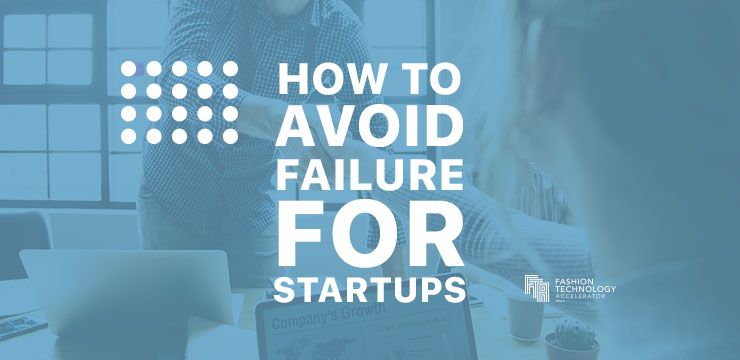

Depending on your preferred source of information, the expected survival rate of a startup ranges between 10% and 33%. This means that out of a batch of 10 startups, just 1 will manage to take it to the next level and thrive. The rest of the pack will not make it for different reasons that we will explore in detail.
The inspiration for this article comes from a notable post from CBInsights, focused on the top 20 reasons for failure in the startup world. As we deal with various fashion technology startups through our acceleration and training programs, our intention is to give you sound examples coming from the fashion industry to better understand the tricky parts of being an entrepreneur on a daily basis.
Are you still thinking about launching your business? We’ve put together a checklist to help you start with the right attitude since the beginning, avoiding common mistakes that could sink your growth. Keep in mind that just 18% of first-time entrepreneurs are successful, meaning that resilience and experience play a huge role in defining your success in the industry.
Worry not, for now. Discover what could go wrong and pave the road for a brighter future. Read on the full article or just download the free ebook version.
*You will receive the ebook in your inbox
Let’s analyze the 5 most important reasons for your startup failure. We will describe each reason in detail with practical examples, a question you need to answer and various insights to help you succeed in your entrepreneurial journey.

Why should people be interested in your company?
If you launch a product solely relying on intuition, chances are you’re bound to fail. This is the most relevant reason for startup failure, and it stems from overconfidence in your understanding of the market.
While fashion startups can still benefit from niches, the market is highly fragmented and making people care about your product is a constant fight. Dwindling loyalty and nonstop evolution of customers’ desires represent concerns for bigger brands which are then transmitted also to up-and-coming fashion brands. Chances are you will launch or have launched a company that faces tenacious competition, and carving your space will be tougher going forward.
Think about who your buyer personas are and how they may find alternatives in the market. If you think they can’t find any, this is quite debatable. As a general rule of thumb, if you don’t have any competitors, chances are you have not scouted the market enough. If other companies are not exactly like yours, a proper product market fit research is necessary to avoid costly false starts and tweak your value proposition before launching to the public. Assumptions about your pricing, positioning and value proposition will be heavily affected by what happens during your first month of operations.
Let’s say you are launching an eco-friendly beauty company in your country. What is the current state of the industry? Is it growing as a trend or not? Which are the most important actors and how are they positioned on the market?
Or maybe you are launching a fashion technology startup that makes in-store augmented reality a piece of cake. Are brands looking forward to this? If they had to do it now without your help, how could they? If they are not using these technologies, why is that?
Ultimately, this comes down to test the strength of your value proposition. If it is not strong enough, the company won’t survive.

Are you planning your strategic moves (1-5-10 years) and the money needed to execute them?
Failing to raise additional funding while scaling up is the nail in the coffin for many promising companies. This is especially challenging because fundraising is a necessary evil of any fashion startup, given the resources needed for expansion.
For example, shifting from a purely online player to offline, increasing your production consistently or aggressively pursuing user growth sacrificing profitability in the short term causes the company to ask for additional funds to operate at its fullest. Time is of the essence, as starting a fundraising campaign too late could significantly reduce the runway you currently have and starting too early without clear metrics would make convincing investors a difficult task.
CrunchBase is a powerful ally to understand the ticket needed to reach certain numbers. Zalando (477M $ raised), Farfetch (700M $) and Stitch Fix (122M $) have all been successful in raising money in different rounds, carefully planning their next expansion while keeping an eye on their cash flow.
Be aware of your monetary needs and start reaching out to the right people before you involve them directly. Match your use of funds with activities coherently, showcasing your market knowledge and vision to overcome resistance from investors. After all, you are looking for partners, not only for their money.

Do you have the right mix of skills (social and hard) to succeed?
Choosing the perfect people is a primary dilemma for any startup. For example: should you hire a developer? Should you work with creative freelancers? Who is going to take care of the administration?
Finding a co-founder as passionate as you are will prove to be a real challenge, as unexcited professionals could lower your team’s morale and not go the last mile for your success. Promises made while starting the business could fall short and cause discontent among the team, in particular when roles overlap because they have not been defined clearly.
Let’s say you have started a fashion company with 4 team members, heavily committed but sharing the same professional background and skill set. This makes it harder to segment your workload efficiently as there is scarcity in some activities which is compensated by overabundance in others.
Alas, the constant tension among different business units will only increase with new hires, products to be launched and markets to be tackled. This is why finding a CTO is such an important asset of any fashion startup, as technology will play a major role regardless of your offering’s complexity.
Experience is required in any growing business striving for success. If you produce fashion products, experts able to handle the whole process without external supervision are needed. If you are a B2B fashion company, not having somebody inside the team that knows the rules of the game to outperform the competition is a serious threat to your business proposition.
Another important crossroad is choosing between internalizing certain professionals or relying on external resources. Unfortunately, there is no golden rule for this so you will have to test and see what works for you.
Asking yourself if your team is able to keep up with expectations, considering your overall chemistry and skills, is necessary to plan your growth appropriately.

Is your value proposition strong enough to outperform your competitors?
Being good is not enough to survive as a fashion startup. As barriers to entry are relatively low, new entrants are always trying to make an impact and will surely try to attack your total addressable market with diversified marketing tactics.
One example is the so-called “retail apocalypse“. Many companies went out of business for multiple reasons, but the most prominent one was lagging behind more reactive brands who could better tackle customers’ requests and did not overcommit to offline point of sales. As the number of potential online customers was skyrocketing, expenditures made in brick-and-mortar stores were not enough to justify the investment and brought companies to suffer greatly.
If you have a distinctive trait in your value proposition, defending it would be a top priority to avoid being outcompeted. For example, not taking advantage of social media, not securing an exclusivity agreement if you rely on a special fabric or not studying reasons why your business is struggling are bad omens for your business. Companies start debating over these topics when it is already too late, making a change of direction particularly tough to digest and manage for the team.
This is why you are supposed to study your competition nonstop. You never know where your next challenge will come from and you need to be prepared for groundbreaking changes in the market.

Are you leveraging on your KPIs to optimize your performance?
One risk of launching a fashion startup is focusing too much on marketing and less on the finance needed to keep activities rolling. Optimizing profits should be the primary focus of any business and it requires finding a great balance between production costs and price to the public. If you are a direct-to-consumer brand and you cannot find a balance between the two, there is no way you will be able to survive.
Even if you don’t have consulting experience, you will have to deal with numbers creating at least a basic income statement and financial projections. If you don’t have a clear idea of your KPIs, you will face your competition from an unfavorable position.
For example, underestimating what are your Customer Acquisition Cost (CAC) and Lifetime Value (LTV), not grasping your Average Order Value (AOV), how do discounts affect your margins, not tracking your marketing campaigns and your burn rate are all aspects to be carefully evaluated.
Producing a fashion brand makes this even more complex. If you read that a certain brand is restructuring and focusing more on profitability, chances are something went wrong in their KPIs retrieval and analysis.
To avoid drowning under the pressure of cash flow and an unclear understanding of your business, clearly define the key metrics for your business, where are you going to obtain them and why you need them to make informed business decisions.
We have seen the top 5, where issues such as picking the wrong team, not taking into account your cash flow and creating a pointless product could accelerate your failure. Let’s dig deeper with the top 10 now.

Are you making it easy for your customers?
This happens to most fashion technology companies at a certain moment in time. Having the best product in the market does not equate to having a strong, active user base unless you make it easy for them to profit from your features.
In your professional experience, you must have used various technological tools that overpromised about their features and were instead hard to use. The end result was generating more frustration than results. This is exactly what happens when you have a slow website, no communication about product delivery or clunky customer support.
The same line of reasoning is applicable for fashion brands. Creating stunning pieces that are too costly, impossible to wear, or to maintain properly, it fails to deliver a compelling value proposition and the risk is alienating part of your clientele.
Stress this aspect when you craft your user stories, which are focused on how will a prospective client interact with you and your products in different environments (retail, e-commerce, social media, email and more). Forgetting about how your customers are going to create a relationship with you or your products is a major cause for concern.

Do you have a clear, decisive business model?
This is particularly tricky for first-time entrepreneurs. Launching on the market, failing fast and optimizing your value proposition are three pillars of startups inception, but launching any company without a clear business model is a major blunder.
If you have a fashion brand, the business model would be pretty straightforward because you would sell your products to the public. However, complications may arise in case major expected revenue sources are unclear. For example, if your business entails gathering money from advertising, B2B deals or major partnerships, and you have not tested these hypotheses extensively, these will be hard to estimate and difficult to implement if you are unsure about your direction.
Cash flow is fundamental and could represent a major problem for any growing business. For example, it can plague a subscription-based business that is not able to gather a substantial number of recurring users, as well as a startup solely relying on advertising and no knowledge of the industry, or a startup offering a free software overselling its capability to add paid plans at a later stage.
Test how you will make money and take inspiration from your competitors. Validate your assumptions and adapt the “Build, Measure, Learn” loop from the start for better performance and constant optimization of your monetary sources.

Are your marketing campaigns performing as expected? If not, why?
Positioning a fashion startup is challenging, for multiple reasons. Even though you have the best product in the market, gaining traction and raising interest do not come by themselves and require a specific strategy to make you relevant in the market. Studying your buyer personas and where you can find them should be the starting point for any campaign, not an afterthought.
This is not only related to your Instagram Ads campaigns. Marketing as a whole encompasses multiple touchpoints that have to deliver the same experience to customers and you walk a fine line between caring for them and harassing through tailored communications.
One case of what not to do would be Adidas email blast after the infamous Boston Marathon bombing that left 3 dead and almost 300 people injured. The following email title was “You survived the Boston Marathon“, which was surely defined by the marketing team before what happened at the race. Nonetheless, the response from the public was extremely negative and while Adidas can surely survive even after such a backfire, your fashion startup may not recover.
When you craft your marketing strategy, obsess over details. Many activities (creating an editorial calendar, planning marketing automation campaigns, managing social media relationships) require maximum concentration on top of your creativity and could fail to deliver for minor mistakes. Double checking is advisable, in particular when you plan to invest your budget in ads or similar promotional actions.

Are you actively listening to your customers’ requests and comments?
An old adage goes saying that “The customer is always right“. However, many fashion startups stubbornly refuse to listen to their customers and this is one of the main causes for their demise.
Launching fashion products that are not sought after by the market is a risky strategy that could reap unsatisfactory results, so you should always discuss whether you are trusting your instincts or following up on customers’ leveraging on data. This second case has been the recipe for success for companies such as Yoox, Zalando, Zara, and Farfetch.
Setting up a proper social media listening strategy and gathering honest opinions from your customers should be of pivotal importance. An example of what to do avoid is Lululemon and the launch of its “Full-On Luon” pants, which was a disaster for multiple reasons. Customers were looking for thicker fabrics and Lululemon failed to deliver, selling revealing pants which were the cause of backlash on social media. On top of that, the founder ignored their negative comments and expressed that certain body types were not in line with their products. Needless to say, he had to apologize profusely for his remarks.
If you have just launched, take advantage of your early adopters, who won’t mind being asked more specific questions and be of great help for your future endeavors. If you have been in business for a while and you have gathered information about your customers, you can tweak your personas more consciously and better cater their needs with clear-cut initiatives. Be sure not to lose your grip on customer relationships you have fought so hard to create.

Do you boast a clear, shared business strategy?
The focus could be lost for multiple reasons. A misalignment in your strategy could start from a lack of a shared vision inside the company, a personal side-project taking up too much time and other more personal motives.
As your fashion startup grows, multiple business decisions will arise and a proper response will require a unified course of action. Discussing product and market expansion, new hires, potential partnerships, and tests on different business models could either be a goldmine for your growth or a cause for extreme backlash. For example, expanding to China through wholesalers, creating a new product line focused on moms and hiring new people to maximize your e-commerce logistics could all be pitfalls if these actions are not primary concerns for your growth.
Maintaining your focus is tantamount for your company’s success. Try avoiding unnecessary distractions and underperforming activities to commit your team towards a single, univocal goal.
*You will receive the ebook in your inbox
We have seen the top 10 reasons for startup failure, but the last 10 are not to be underestimated. Keep them all in mind and, if you like, download our ebook (button above) to print it out and fine-tune your strategy!

Is your timing optimized for maximum exposure and minimum operational complexity?
It is very easy to launch your fashion startup at the wrong time. For example, launching a sweater collection in July, launching briefly after another early-stage startup selling clothes similar to yours has gathered great media publicity, or launching a specific fashion technology solution when a technology giant has started a similar initiative.
This is partially beyond your control. However, setting up specific Google Alerts and constantly studying your competition are great assets to reduce this inconvenience. Eric Ries even suggests that not launching is the best way to start a company, so that you can also take care of these potential problems when you start your business. For example, getting many customers on your first day of operation means little if you are hindered by technical problems and fail to meet their expectations.
If you feel like you have launched your fashion collection at the wrong time, you are in great company. Take Marc Jacobs and his 1993 Perry Ellis collection: a flop then, a cult afterward and the main inspiration for a new collection 25 years later.
Be aware of the context surrounding your launch, whether it’s software or a new collection. Understand if the market is ready for your value proposition and plan it at best as the timing does make a difference. As we have seen, it may be that it’s too early to gain market traction despite having a great product.

Are your current or potential investors completely aligned with your vision?
There is a reason why there is such a huge buzz around “smart money“. Managing relationships is tougher when individuals do not understand your business at its fullest or when they are perceived as bossy by your team. If you are able to get on board those investors that can give you an added value on top of the money offered, this is a huge plus also to reduce the tension and gain additional insights on the market you are attacking.
For example, a fashion brand has clear timelines for launching new collections and investors may not fully grasp what is at stake. The same could happen for a more technological startup, when suggestions from investors may be completely off due to tech limitations or different takes on the market to be penetrated. They may not even understand how your potential customers may use the solution you are offering, requiring additional explanations to take business decisions and ultimately slowing you down. If this persists, heated conflicts may arise.
This holds true also when your startup receives money from more institutional actors. Understanding if they are passive or active investors, clearly defining their involvement, is a prerequisite to get along well and grow the company.

If you were to change one aspect of your business, which would it be?
Pivoting means changing your course of action and you completely change your way of doing things. Startups go through this tough phase at various moments in time, especially if they are deeply imbued in technology. Companies such as Instagram (a check-in app, at first) and Pinterest (the previous version allowed people to browse and shop their favorite retailers sending updates when specific products were on sale) have undergone successful changes that have brought them to more exciting opportunities.
However, this is not always the case. Let’s say you change your product mix completely, now selling suits instead of pants. Or you dismantle your beauty e-commerce to create a marketplace for sustainable fashion. Or you start selling to professionals in B2B and stop your B2C sales indefinitely. These decisions can be a major cause for discontent inside your team and hinder your possibilities for growing the business, especially if these changes are dictated by the market and not a thoughtful decision endorsed by the team as a whole.
If you change, you have to do it for a well-documented reason. Pivoting for the sake of it is a surefire mistake.

Are you extremely passionate about what you are doing or not?
While you are extremely passionate about the fashion world, it could be that you are not as passionate about other sides of the business. For example, dealing with suppliers and logistics is not the same as the creative effort required to create a collection or a marketing campaign for social media.
Startups could suffer greatly from this lack of passion, reducing their effort into specific fields and giving too much importance to less relevant aspects of the business which are more in line with their experience.
Entrepreneurship is not for everybody, as giving 100% and more will be always required for your first years of operations. This is why investors are so cautious about part-time entrepreneurs that are still employed in bigger corporations. Since you are not as passionate as to leave your current job to fulfill your dream, they don’t see why they should invest in your vision.

Are you ready for international expansion, having studied your market thoroughly?
Any company could be successful in one market and struggle in others. Among countless others, this has also been the situation for behemoths such as Amazon (China), UBER (Europe as a whole) and Wal-Mart (Germany).
There are major reasons for this disparity. Studying the market extensively is fundamental to properly address customers and offer them a comparable experience to your local market, but this is not the case for most startups. While expanding your target markets, the risk is spending a lot of resources and credibility for a sub-optimal result, which could also hurt your performance on your primary market.
Ask yourself whether your favorite international fashion startups are currently operating in your home country. If this does not hold true, why is that? For example, many examples of successful US startups (rental with Rent The Runway, personalized boxes with Stitch Fix or bra producers with Third Love) are yet to find the same market penetration overseas.
Various cases of tone-deaf marketing campaigns from respectable fashion companies (D&G in China, H&M with the “Coolest Monkey in the Jungle” sweater, and Nike crafting a fire emblem that resembled the word Allah in Arabic) are clear examples of what to escape when trying to expand your target market.
As a startup, you should be especially careful to avoid alienating your international customers because your resources are way more limited than those of established fashion brands.

Are you actively looking for investment and sparking interest around the right people?
In a crowded market, it is hard to gain buzz around your fashion startup. In particular, it is not easy to be spotted by business angels and venture capital players who could be on the lookout for startups working in broader markets.
Taking a successful company as a reference is a plus, as long as it does not reduce the strength of your brand. This is why many startups addressed their value proposition as “the Airbnb for X“, to reduce complexity and reach out to less specialized actors.
The same tactic can be used by fashion brands. For example, if you are launching a made in Italy direct to consumer company focused on sustainability you could say that you are “The Italian Everlane“. All these activities are meant to spark interest with investors. This interest is then to be confirmed with more specific documentation.
As you are well aware of, receiving a first seed investment is not the end of the journey, as fundraising is a constant activity for any growing company. Fashion is a capital intensive market that will surely require various rounds of funding and failing to raise even a small seed investment could be devastating.

Are you protecting your brand appropriately?
Legal challenges are a real issue for most startups. In fashion, protecting your design and logo is of pivotal importance to avoid copycats and costly litigations.
If you launch your innovative brand and you already see 10 companies selling a similar design on Alibaba, it will be hard for you to grow your brand image and keep these competitors at bay. Another underestimated topic is related to insurances of products and similar bureaucratic complexities which require time and resources to be addressed properly.
Looking at the market, many established companies are currently facing long trials to define whether a company copied the design of a collection created by a competitor. One example is Gucci v Forever 21, where the debate is over the use of colored stripes for jackets.
While Forever 21 can still operate despite this legal threat, a fashion startup would face immense obstacles to operate as expected when faced with such accusations.

Are you involving others in your startup or it’s an extremely closed circle?
Surprisingly enough, one of the main reasons for failing is related to missed opportunities inside your network.
Startups trying to do everything by themselves risk losing support from peers, investors, and customers, as they struggle to deliver a high-quality product. Fashion requires educated insights on many operational activities and this knowledge should not be underestimated. If you have studied fashion, you already have a great network of people who could help you out on specific issues related to your startup. If you haven’t, this is the right moment to expand your horizons and start immersing yourself in this sector to foster new professional relationships.
This reason for failure is a wake-up call to directly involve your peers in your company and ask for their feedback and professional help. Not sharing meaningful insights about your company out of fear of people stealing your idea or fearing judgment from others are two capital errors for any startup.
Bottom line: talk about your venture and do it often, trying to leverage on who you know to gather new perspectives and suggestions for improvement.

Are you surfing the tsunami or drowning?
Burnout is a real issue that is under scrutiny in the startup world. This is particularly evident in fashion, as the industry is fast-paced and in constant evolution. Many brands are still unprepared for the digital era and the constant threat of upcoming companies such as Zara has caused major turmoils inside creative departments, causing mass departures and a more stressful environment.
As Diane von Furstenberg said: “We live in a moment of total disruption as our tools change and the speed increases. Everyone is surfing a tsunami, trying to understand how to deal with waves of so much information, so many images.“
Many fashion designers and entrepreneurs quit under pressure, given the multiple sources for stress that could come from the market, employees, and investors. Combine this with being a pillar of any emerging startup working 24/7 with limited external support and, unfortunately, it’s easy to understand what could happen.

Do I need to change my strategy drastically?
As we have seen, pivoting can go bad. However, not changing your strategy could be as detrimental to your success. Look at the following cases:
One notable example coming from the industry would be Tie Rack. The company went out of business because they only sold scarves, ties, and cufflinks, while customers buying these products were shopping also for other product categories they could not find in their stores. Testing a different product mix would have been beneficial for the company as a whole.
Ask yourself if your current strategy is yielding positive results. If this is not the case and minor tweaks are not sufficient, transforming your business could be the only way forward.
*You will receive the ebook in your inbox

All of the above is a lot to process. Inspiring and scary at the same time, isn’t it?
20 reasons for your potential demise could also spark new ideas and be the reason for your success.
Quoting Sun Tzu, general and philosopher:
“If you know the enemy and know yourself, you need not fear the result of a hundred battles. If you know yourself but not the enemy, for every victory gained you will also suffer a defeat. If you know neither the enemy nor yourself, you will succumb in every battle.”
With our insights, we hope we gave you better tools to know your enemy. Which, in most cases, is a lackluster strategy to tackle extremely complex challenges such as creating the next unicorn in fashion. Be honest with yourself and keep in mind that continuous iterations will be needed to tweak your company and thrive, continuously optimizing your processes and flow to outperform your competition.
Still not satisfied? Have a look at our acceleration and training programs!

Marco Filocamo is Head of Operations of Fashion Technology Accelerator.
He manages the Acceleration Program, offers guidance in our Masterclasses, and is the first point of contact for promising startups through our Mentoring sessions.